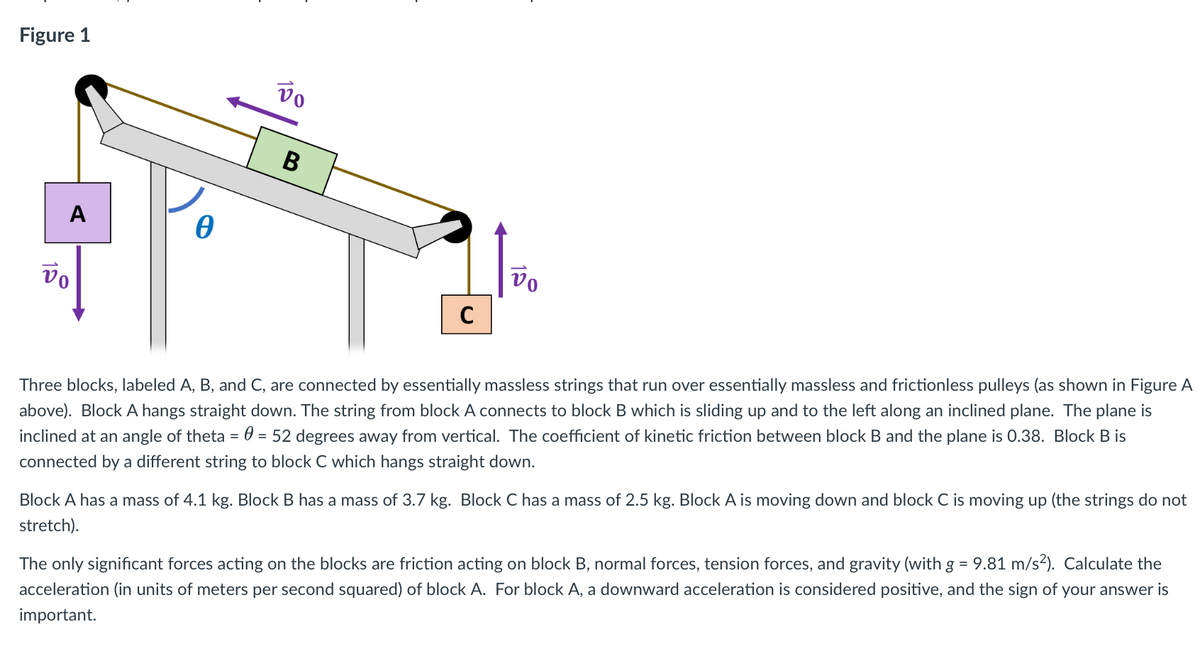Figure 1 A Three blocks, labeled A, B, and C, are connected by essentially massless strings that run over essentially massless and frictionless pulleys (as shown in Figure A above). Block A hangs straight down. The string from block A connects to block B which is sliding up and to the left along an inclined plane. The plane is inclined at an angle of theta = 0 = 52 degrees away from vertical. The coefficient of kinetic friction between block B and the plane is 0.38. Block B is connected by a different string to block C which | straight down. Block A has a mass of 4.1 kg. Block B has a mass of 3.7 kg. Block C has a mass of 2.5 kg. Block A is moving down and block C is moving up (the strings do not stretch). The only significant forces acting on the blocks are friction acting on block B, normal forces, tension forces, and gravity (with g = 9.81 m/s?). Calculate the acceleration (in units of meters per second squared) of block A. For block A, a downward acceleration is considered positive, and the sign of your answer is important.
Figure 1 A Three blocks, labeled A, B, and C, are connected by essentially massless strings that run over essentially massless and frictionless pulleys (as shown in Figure A above). Block A hangs straight down. The string from block A connects to block B which is sliding up and to the left along an inclined plane. The plane is inclined at an angle of theta = 0 = 52 degrees away from vertical. The coefficient of kinetic friction between block B and the plane is 0.38. Block B is connected by a different string to block C which | straight down. Block A has a mass of 4.1 kg. Block B has a mass of 3.7 kg. Block C has a mass of 2.5 kg. Block A is moving down and block C is moving up (the strings do not stretch). The only significant forces acting on the blocks are friction acting on block B, normal forces, tension forces, and gravity (with g = 9.81 m/s?). Calculate the acceleration (in units of meters per second squared) of block A. For block A, a downward acceleration is considered positive, and the sign of your answer is important.
College Physics
11th Edition
ISBN:9781305952300
Author:Raymond A. Serway, Chris Vuille
Publisher:Raymond A. Serway, Chris Vuille
Chapter1: Units, Trigonometry. And Vectors
Section: Chapter Questions
Problem 1CQ: Estimate the order of magnitude of the length, in meters, of each of the following; (a) a mouse, (b)...
Related questions
Topic Video
Question

Transcribed Image Text:Figure 1
В
А
Three blocks, labeled A, B, and C, are connected by essentially massless strings that run over essentially massless and frictionless pulleys (as shown in Figure A
above). Block A hangs straight down. The string from block A connects to block B which is sliding up and to the left along an inclined plane. The plane is
inclined at an angle of theta = 0 = 52 degrees away from vertical. The coefficient of kinetic friction between block B and the plane is 0.38. Block B is
connected by a different string to block C which hangs straight down.
Block A has a mass of 4.1 kg. Block B has a mass of 3.7 kg. Block C has a mass of 2.5 kg. Block A is moving down and block C is moving up (the strings do not
stretch).
The only significant forces acting on the blocks are friction acting on block B, normal forces, tension forces, and gravity (with g = 9.81 m/s²). Calculate the
%3D
acceleration (in units of meters per second squared) of block A. For block A, a downward acceleration is considered positive, and the sign of your answer is
important.
Expert Solution
This question has been solved!
Explore an expertly crafted, step-by-step solution for a thorough understanding of key concepts.
Step by step
Solved in 2 steps with 1 images

Knowledge Booster
Learn more about
Need a deep-dive on the concept behind this application? Look no further. Learn more about this topic, physics and related others by exploring similar questions and additional content below.Recommended textbooks for you

College Physics
Physics
ISBN:
9781305952300
Author:
Raymond A. Serway, Chris Vuille
Publisher:
Cengage Learning

University Physics (14th Edition)
Physics
ISBN:
9780133969290
Author:
Hugh D. Young, Roger A. Freedman
Publisher:
PEARSON

Introduction To Quantum Mechanics
Physics
ISBN:
9781107189638
Author:
Griffiths, David J., Schroeter, Darrell F.
Publisher:
Cambridge University Press

College Physics
Physics
ISBN:
9781305952300
Author:
Raymond A. Serway, Chris Vuille
Publisher:
Cengage Learning

University Physics (14th Edition)
Physics
ISBN:
9780133969290
Author:
Hugh D. Young, Roger A. Freedman
Publisher:
PEARSON

Introduction To Quantum Mechanics
Physics
ISBN:
9781107189638
Author:
Griffiths, David J., Schroeter, Darrell F.
Publisher:
Cambridge University Press

Physics for Scientists and Engineers
Physics
ISBN:
9781337553278
Author:
Raymond A. Serway, John W. Jewett
Publisher:
Cengage Learning

Lecture- Tutorials for Introductory Astronomy
Physics
ISBN:
9780321820464
Author:
Edward E. Prather, Tim P. Slater, Jeff P. Adams, Gina Brissenden
Publisher:
Addison-Wesley

College Physics: A Strategic Approach (4th Editio…
Physics
ISBN:
9780134609034
Author:
Randall D. Knight (Professor Emeritus), Brian Jones, Stuart Field
Publisher:
PEARSON